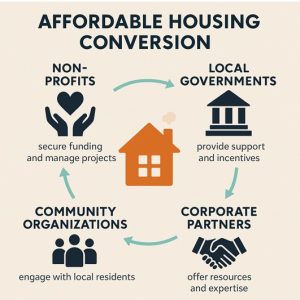By Kevin Smith
Introduction
Affordable housing remains a pressing challenge in urban and suburban communities, where escalating property values and rental rates continue to displace lower-income residents. Converting existing market-rate multifamily properties, particularly aging assets built between the 1960s and 1980s, into affordable housing offers a practical, scalable, and sustainable solution for both owners and residents. This article explores the benefits of these conversions with a focus on the vital roles of non-profit organizations, local governments, and corporate partners. It also underscores the importance of tenant services in driving community transformation and outlines the financial incentives that make these projects both viable and attractive.


The Case For Conversion
According to the U.S. Census Bureau, approximately 30% of multifamily housing inventory was built between the 1960s and 1980s. These properties are prime candidates for conversion due to their aging infrastructure and potential for adaptive reuse. Compared to new construction, conversions can be completed faster, at lower cost, and with less disruption to existing communities. Furthermore, they capitalize on existing infrastructure and neighborhood networks, accelerating the delivery of much-needed affordable housing.
Role of Non-Profit Organizations
Non-profit organizations play a crucial role in the affordable housing sector. They often provide funding, expertise, and resources to facilitate the conversion of market rate properties into affordable housing. Non-profits such as Habitat for Humanity, Enterprise Community Partners, and the National Housing Trust have pioneered programs that support such conversions, ensuring that the needs of low-income families are met.
Non-profit organizations are essential facilitators of affordable housing conversions. Their multifaceted support includes:
- Funding and Grants: Non-profits assist with securing grants, tax incentives, and low-interest financing, reducing the economic risk for property owners and developers.
- Technical Expertise: They offer renovation guidance and ensure compliance with affordable housing standards, helping to streamline conversion processes.
- Advocacy and Outreach: Many non-profits engage in policy advocacy and community engagement, building public support and connecting stakeholders with crucial resources.
- Tenant Services: With deep community ties, non-profits can provide educational programs, health services, and youth initiatives that support families, adults, and seniors throughout the lifecycle.
Local Government Support
Local governments are indispensable partners in expanding affordable housing. Their contributions include:
- Financial Incentives: Tax abatements, development subsidies, and expedited permitting processes make conversions more financially feasible.
- Policy Alignment: Zoning modifications and regulatory flexibility enable adaptive reuse of existing properties.
- Public-Private Partnerships: Municipal collaboration with developers and non-profits accelerates project delivery and aligns public resources with private capital
Collaboration with Other Entities
A successful conversion initiative often involves a broad coalition of stakeholders:
- Private Investors: Impact investment models attract private capital by offering both social and financial returns. Affordable housing offers steady, long-term revenue with low vacancies.
- Community Organizations: These groups ensure that projects are responsive to resident needs and promote equitable development outcomes.
- Philanthropic Foundations: Foundations like the Ford Foundation and the Bill & Melinda Gates Foundation provide catalytic funding that helps bridge financing gaps and pilot innovative models.
Corporate Contributions: The Amazon Housing Equity Fund
Corporate entities are increasingly recognizing their role in supporting affordable housing. A leading example is the Amazon Housing Equity Fund, which provides low-interest loans and grants to preserve and create affordable units in areas where the company has a significant footprint. Through direct investment in developers and housing partners, this initiative demonstrates how corporations can make a measurable impact on housing equity.

Tenant Services as Catalysts for Change
Affordable housing is most effective when paired with robust tenant services. These offerings enhance residents’ quality of life and foster resilient, stable communities:
- Educational Programs: Financial literacy, career training, and after-school programs equip residents with tools for long-term success.
- Health and Wellness: Onsite clinics, mental health services, and wellness programs support holistic community health.
- Community Building: Events, workshops, and tenant leadership programs cultivate a sense of belonging and mutual support.
Partnering with seasoned non-profits to deliver these services ensures they are culturally competent, effective, and efficiently managed.
Financial Advantages of Conversion
There are substantial financial benefits to converting market rate multifamily properties to affordable housing. These advantages can be realized by property owners, investors, and the community at large.
Consistent Revenue: Affordable housing projects often benefit from long-term occupancy rates, providing a stable and predictable revenue stream for property owners and investors. The demand for affordable housing remains high, ensuring consistent rental income.
Access to Diverse Funding: Projects that convert properties to affordable housing can access a wide range of funding sources, including government grants, non-profit funding, and impact investments. These resources can reduce the overall financial burden and enhance project feasibility.
Tax Incentives: Property owners and developers may be eligible for various tax benefits and credits when they convert market rate properties to affordable housing. These tax incentives can significantly improve the financial returns of such projects.
Conclusion
Converting aging market-rate multifamily properties into affordable housing represents an actionable and efficient response to the nation’s housing crisis. With support from non-profits, local governments, corporate partners, and community stakeholders, these conversions not only preserve housing stock but also promote economic inclusion and neighborhood stability. By pairing affordable units with comprehensive tenant services, stakeholders can ensure long-term success and resilience for residents. Embracing this model supports the creation of thriving, inclusive communities where all individuals have the opportunity to live with dignity and security.



